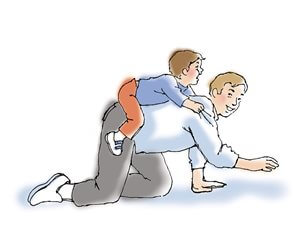

Continued — By Lauren Lowry
Clinical Staff Writer and Hanen SLP
People games can be so much more than a few tickles and laughs – they can also provide a wonderful opportunity to encourage your child’s communication skills. You can do this by using the SPARK strategy described in the It Takes Two To Talk© guidebook [1]:
Start the same way each time – Name your game and invite your child to play with you by using the name of the game (“Let’s play tickles”). If possible, do an action or gesture when you say the name of the game (e.g., put your hands in the tickling position) to help your child understand your words. Starting the game the same way each time helps your child understand your words and know what to expect.
Plan your child’s turn – Think about a moment in the game when your child can participate in some way. Maybe he can show you he wants more of the game once it ends by moving his body, looking at you, or reaching. Perhaps he could make a sound or use a word. More verbal children might try to say a key phrase during the game (e.g., “I found you!” during Hide and Seek).
Adjust the routine so your child can take a turn – You can adjust the game by pausing at a key moment to let your child participate. Most games have a high point (the most fun part of the game!), like when you fall down during Ring Around the Rosie, or the moment when you tickle your child at the end of “This Little piggy”. Pausing right before the high point builds excitement and encourages your child to participate in order for the game to continue. You can encourage your child to participate further by giving a cue (or hint), like leaning in close, opening your eyes wide with anticipation, using a gesture or action to remind your child what to do, or asking a question (“Do you want more tickles?”).
Repeat the same actions, sounds & words – This repetition helps your child learn what’s coming next, and the words that go along with each part of the game.
Keep the end the same – Let your child know that the game has ended by saying and doing the same thing each time you play. Then your child knows that the game is over. The consistent end of the game also teaches him a way of ending the game himself eventually. Some games have a natural ending (at the end of Ring Around the Rosie everyone says, “We all fall down” and they fall down). If your game doesn’t have a natural ending, you can say something like “No more tickles. We’re all done!”
So put away the toys for a few minutes and let your child play with the BEST toy in your home! And by adding some “SPARK” to your people games, you’ll have a terrific time together while providing your child with new opportunities to communicate.
References
- Weitzman, E. (2017). It Takes Two to Talk: A Practical Guide for Parents of Children with Language Delays (5th ed.). Hanen Early Language Program: Toronto, Ontario.
- DeVeney, S., Cress, C. J., & Lambert, M. (2016). Parental directiveness and responsivity toward young children with complex communication needs. International Journal of Speech-Language Pathology, 18:1, 53-64.